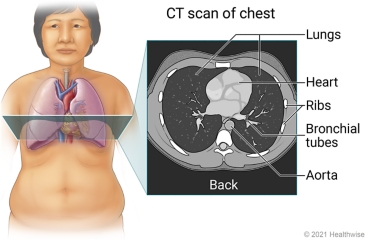
What is it?
A CT (computed tomography) scan uses X-rays to make detailed pictures of your body and structures inside your body. A CT scan of the chest can give your doctor information about your lungs, your heart, and other structures in your chest.
During the test, you will lie on a table that is attached to the CT scanner. The CT scanner is a large doughnut-shaped machine.
Why is this test done?
A CT scan of the chest can help find problems such as infection, lung cancer, blocked blood flow in the lung (pulmonary embolism), and other lung problems. It also can be used to see if cancer has spread into the chest from another area of the body.
A low-dose CT scan is a different type of chest CT scan. It may be used as a lung cancer screening test for some smokers. Your age and how much you've smoked help your doctor decide if this would be a helpful test for you. This type of CT scan uses less radiation than a regular chest CT scan.
How do you prepare for the test?
- In general, there's nothing you have to do before this test, unless your doctor tells you to.
- Tell your doctor if you get nervous in tight spaces. You may get a medicine to help you relax. If you think you'll get this medicine, be sure you have someone to take you home.
How is the test done?
- You may have to take off jewelry.
- You will take off all or most of your clothes and change into a gown. If you do leave some clothes on, make sure you take everything out of your pockets.
- You will lie on a table that is attached to the CT scanner.
- The table will slide into the round opening of the scanner. The table will move during the scan. The scanner moves inside the doughnut-shaped casing around your body.
- You will be asked to hold still during the scan. You may be asked to hold your breath for short periods.
- You may be alone in the scanning room. But a technologist will watch you through a window and talk with you during the test.
How does the test feel?
- The test will not cause pain, but some people feel nervous inside the CT scanner.
- If a medicine to help you relax (sedative) or dye is used, you may feel a quick sting or pinch when the I.V. is started. The dye may make you feel warm and flushed and give you a metallic taste in your mouth. Some people feel sick to their stomachs or get a headache. Tell the technologist or your doctor how you are feeling.
How long does the test take?
The test will take about 30 to 60 minutes. Most of this time is spent getting ready for the scan. The actual test only takes a few minutes.
What happens after the test?
- You will probably be able to go home right away.
- You can go back to your usual activities right away.
- If dye was used, drink lots of liquids for 24 hours after the test, unless your doctor says not to.
Follow-up care is a key part of your treatment and safety. Be sure to make and go to all appointments, and call your doctor if you are having problems. It's also a good idea to keep a list of the medicines you take. Ask your doctor when you can expect to have your test results.
Where can you learn more?
Go to http://www.healthwise.net/patientEd
Enter V648 in the search box to learn more about "CT Scan of the Chest: About This Test".
Current as of: March 26, 2025
Author: Ignite Healthwise, LLC Staff
Clinical Review Board
All Ignite Healthwise, LLC education is reviewed by a team that includes physicians, nurses, advanced practitioners, registered dieticians, and other healthcare professionals.

